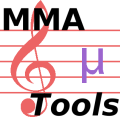
Pitch Analyzer History
| before 1990 | I became interested in pitch analyzing when my wife Stefanie Stadler Elmer worked on her PhD thesis about pitch singing quality of young children. She analyzed here audio tapes by ear with the help of an automatic tuner (KORG AT-12). Such a device is usually used to tune musical instruments. This can be done either traditionally by ear or automatically with a built-in pitch analyzer. In the first case the tuner produces a tone of a well-defined pitch. In the second case it analyzes the sound and shows the pitch by an LED on a chromatic scale. In addition a needle on an analog scale shows the deviation in cent. Analyzing audio tapes with this automatic tuner was very cumbersome because the events are so short and the tuner wasn't able to freeze or to store the pitch for better reading. Thus I started to look for a better technical solution. |
| 1990 | I bought for our computer (an ATARI ST1024) an 8-bit sound sampler (hardware and software) and I read the monography of Hess (W. Hess: Pitch determination of speech signals: Algorithms and devices. Springer Verlag, 1983) in order to get some ideas about extracting the pitch from sound data. Then I started to develope an analyzing tool for the ATARI ST. But this project was interrupted because I got a research grant and we spent a year in San Diego. Back from the States I didn't continue this project because our kids absorbed all the energy of my wife. |
| 1994 | Our kids had become older and my wife had been resuming her
research on children's singing. Now she had here own
PC (Intel 386, 40 MHz, sound card, Windows 3.1).
Thus I developed a pitch analyzer for Windows 3.1 instead for
ATARI ST.
I wrote the application in C++ by using Borland's OWL library for the graphical user interface. The application used a simple time based algorithm (the same now used in the analyzer 'Minimum Maximum Analyzer') using only integer arithmetics. The result had been shown graphically (superimposed with the data) and numerically. Because this tool was not able to record audio data or to navigate through the data, we used a commercial sound editor (CoolEdit V1.34) for these purposes. The analyser gots the data from the editor via the scratch pad. In the following years this pitch analyzer had become the working tool of my wife. Without this tool she wouldn't been able to get all her important results about the singing development of children. There was growing interest by other researchers in using this tool. |
| 1999 | In July 1999 I decided to write a completely new pitch
analyzer. I thought it would be a nice idea to develop
a version which is independent from
|
| 2001 | In January 2001 I published the Pitch Analyzer (V1.1) on the Web as a free tool. |
| 2006 | During the years I got only little response on the published application. But at the end of 2005 and the beginning of 2006 more and more colleagues of my wife used or wanted to use the Pitch Analyzer. But they are faced with some problems and bugs. Therefore I decided to overhaul the Pitch Analyzer. No features has been added but now it needs Java Runtime Environment 1.4.2. The advantage is that no tricks with audio playing are necessary. |
History of Versions
| 0.1 | September 1999 | First version based on Java Media Framework (JMF). |
| 0.2 | October 1999 | Applet version. Frequency peak analyser. |
| 0.3 | January 2000 | Improved GUI. |
| 1.0 | September 2000 | Version based on JDK1.0.2. Two players one based on sun.audio.AudioPlayer and one based on JMF |
| 1.1 | January 2001 | Exception pop up. |
| 2.0 | March 2006 |
|
(C) 1994-2015 Franz-Josef Elmer All rights reserved. Last modified: 8/2/2015